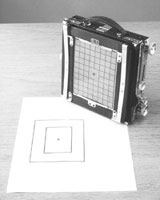Do It Yourself
Make Your Own Custom Ground Glass
This month's project is a simple way
to replace or customize the ground glass of any large format camera.
Only a few inexpensive materials are needed to make the glass itself,
but you will need the use of a computer and a laser or ink jet printer
for the optional grid overlay. Each piece of glass costs only a couple
of dollars and can be made in an hour or so by anyone with basic do-it-yourself
skills. If you are not computerized, there are office support stores
where such equipment, along with technical assistance, can be had on
a per-hour basis. |
|||
A source of thin glass
is just a few aisles away in the picture frame department. Carefully measure
the recessed area of the camera back into which the ground glass will
fit, then select a similarly sized frame. Check several different styles
with a metric ruler, as the actual glass size varies considerably. Although
you can sand down the edges of an oversized glass to fit the camera, it
is generally easier to build up the ground-glass receiving area with small
strips of wood or cardboard to make it accept a slightly undersized piece.
Do not use "non-glare" glass or acrylic material.
You can cut the corners off with an ordinary hand-operated glass cutter if you wish, but it is a lot easier to leave them alone. Cut corners allowed the photographer to look into the camera from behind and quickly see if the shutter was open (a stopped-down aperture being easy to see if viewed directly even if its image was hard to discern on the ground glass without a dark cloth), as well as let air flow in and out when the bellows was rapidly extended or compressed. Square corners require only that you check the shutter from the front and work the bellows slowly. Clean the picture frame glass thoroughly and apply the spray finish as shown. |
|||
The grid overlay, made on 3M Transparency
Film, is an option that can be added to this or an existing ground glass.
It aids in composition, especially with architectural subjects where straight
and level is the order of the day, as well as when a rollfilm back making
6x7cm or 6x9cm images is used in a 4x5" camera. In addition to low cost,
making your own grid lets you include only those elements desired and
eliminates the visual clutter typical of commercially-made multiple-format
ground glasses. Any format can be delineated, by a full rectangle or just
corner brackets, and the overlay can be quickly removed. |
- Log in or register to post comments




































